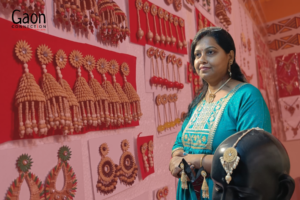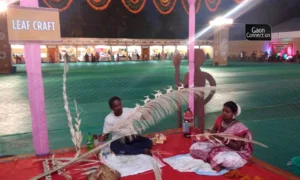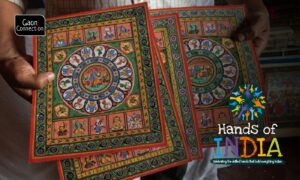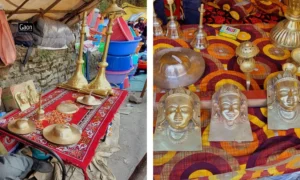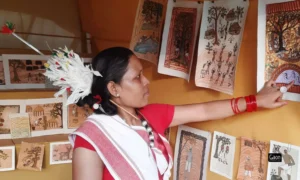Noya (West Midnapore), West Bengal
Anwar Chitrakar is giving final touches to a scroll painting of Lord Krishna and Radha. He has been working for several hours a day as he has to soon send it to an art gallery in Kolkata.
Anwar, resides in Noya village in West Midnapore district, West Bengal, around 125 kilometres from Kolkata, the state capital. He is among the 300 Muslim artisans in the village who create pattachitra, the traditional cloth-based scroll paintings. The artists are also referred to as potuas. All the artists carry the surname of Chitrakar, which means artist in Hindi.
“Our surname ‘Chitrakar’ tells you about our occupation,” 44-year-old Anwar told Gaon Connection. “We paint scenes from the Ramayana and Mahabharata. We have been doing this for generations,” he added.
According to Anwar there is reverence amongst the artists for the Hindu gods and goddesses. “They are our source of livelihood,” he said, simply.
Also Read: The Mughal-era craft of Gulabi Meenakari gets a boost in Varanasi

Pattachitra tell stories from the Ramayana and Mahabharata and from tribal folklore.
Pattachitra – the rich legacy
Pattachitra is traditional cloth based scroll paintings originating in West Bengal and Odisha. Patta refers to the piece of cloth on which the artisans do intricate paintings with natural colours, that tell stories from the Ramayana and Mahabharata and from tribal folklore.
“It is an art form that goes back several centuries. While we are not sure, we have heard that some of the artists also worked on the paintings in the Ajanta and Ellora caves (in Maharashtra),” Bahar Chitrakar, a 70-year-old veteran artist, told Gaon Connection. According to him these artists migrated to east India and started the tradition of Pattachitra.

Patta refers to the piece of cloth on which the artisans do intricate paintings with natural colours.
The artists not just painted, they also sang about their pattachitras narrating the stories to people who might not have heard them before. “We visited villages barefoot and people gave us alms after we sang for them. We have stopped doing that these days, but still we compose and sing songs,” Bahar said.
The pattachitra artists of Noya use natural colours to paint. “We use natural colours for our work like red from Hingula, a mineral, and yellow colour is made from yellowstone. We make black colour from a dye made from burnt coconut shells,” 45-year-old Mohim, another potua from Noya said. “The use of colours is limited to red, yellow, Indigo, black and white.
Interestingly, while the artists are all Muslims they have been involved with the pantheon of Hindu gods and goddesses. According to Anwar their ancestors also helped make the Durga idols during the Puja, but because the zamindars (landlords) of the time did not want them, as Muslims to do so, many of the artists adopted a Hindu name. “Some of us still follow the tradition of having two names,” Anwar said.

The pattachitra artists of Noya use natural colours to paint.
Symbol of women empowerment
Nearly 200 of the artists in the village are women. They have carried forward the legacy of the art as many of the male members have migrated in search of work elsewhere.
“We do the work during our free time which gives us income to run our family,” Khalida, a 25-year-old artist, told Gaon Connection.
“While earlier our songs were only about mythological events and epics, we now sing about social issues such as the environment, the evils of dowry, etc. It is a way to attract the younger generation to come and listen to what we have to say at exhibitions and fairs,” Khalida said.
In order to keep the art form going and relevant, the artists now paint on kettles, tea glasses and even plastic bottles. “We want them to be used as gift items so that the younger generation finds them attractive,” said Hoshiara to Gaon Connection.
Bahadur, a 50-year-old potua, has gone the extra mile and converted his house into a museum where he displays pattachitra work. “I have a stock of over 12,000 scroll paintings which have been collected from various places over the years. Some are even forty-fifty years old. I also have a collection of several thousands of books related to different forms of art. It is my attempt to prevent the art from getting lost with the passage of time,” he said.
Also Read: Tikuli Art of Bihar: From adorning women to empowering them

Pattachitra is traditional cloth based scroll paintings originating in West Bengal and Odisha.
Reviving Bengal’s Pattachitra
Banglanatak dot com, a non-profit working for the art in West Bengal is doing its best to keep the art form alive and shine a light on it.
“We started the work of reviving the art in 2005 which got a boost when the European Union supported it between 2009 and 2011. The state government in association with UNESCO developed Rural Craft Hub between 2013 and 2016 and also built a beautiful resource centre in the village,” Amitava Bhattacharya, founder director, Banglanatak dot com, told Gaon Connection.
“The interventions and support by the European Union, have gone a long way in putting the potuas on the global map. It has facilitated capacity building, market linkages and further collaborations that can only help them,” Bhattacharya pointed out. “It is connecting them to the market worldwide,” he added.
However, the pandemic has dealt a big blow to the artisans. Before the pandemic the artists were in a good place. “We sold the finished products to the wholesalers but we also used to make decent income from tourists who visited our village. We easily made twelve hundred to fifteen hundred rupees per day,” Mohim, a pattachitra artist, told Gaon Connection.
But, everything stopped during the lockdown and the pandemic. And things are still sluggish as visitors are yet to show up, he said.
The Pattachitra artists of Noya hope the government will intervene and help them with resources and platforms to sell their art both within India and outside. “We are not only artisans but we are also a solid example of communal unity, which is greatly needed these days,” Mohim said.







